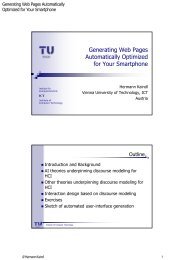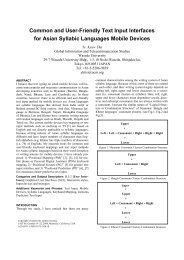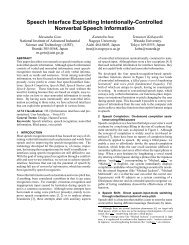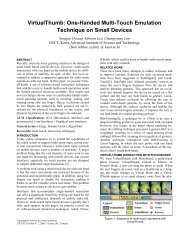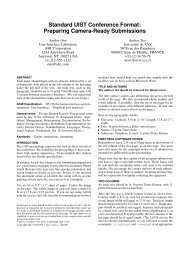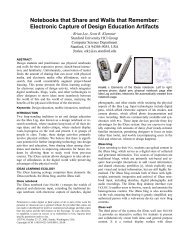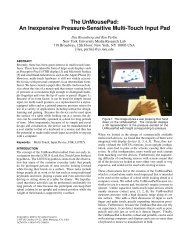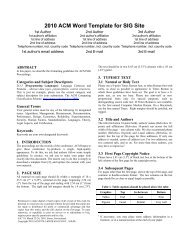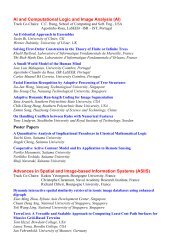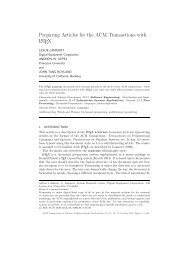API Design Matters Stonebraker and Seltzer - RabbitMQ
API Design Matters Stonebraker and Seltzer - RabbitMQ
API Design Matters Stonebraker and Seltzer - RabbitMQ
You also want an ePaper? Increase the reach of your titles
YUMPU automatically turns print PDFs into web optimized ePapers that Google loves.
lead in establishing the legal framework for the st<strong>and</strong>ard;<br />
it, too, understood the issues in managing open intel-<br />
lectual property. The key part of doing this is to ensure<br />
that everyone contributing has the authority to do so <strong>and</strong><br />
that there is a paper trail from every potential owner of IP<br />
through to the group effort, <strong>and</strong> that the intent to share<br />
is clear even in draft revisions of specifications. The result<br />
was a contract that clearly committed the members of the<br />
working group to promote unrestricted open middleware<br />
through AMQP.<br />
The members of the working group have granted<br />
licenses to the necessary parts of their patent portfolios to<br />
anyone who wants to implement AMQP. You can see the<br />
license grant in the specification itself.<br />
This level of contribution shows the commitment<br />
of the group to open middleware. The AMQP Working<br />
Group’s Web site is http://www.amqp.org.<br />
USer Driven<br />
The AMQP Working Group is quite unique in technology<br />
st<strong>and</strong>ards work because of the heavy involvement<br />
of users. JPMorgan, Credit Suisse, TWIST, <strong>and</strong> to some<br />
degree Cisco are more end users than developers. This<br />
balance leads to a group of people interested in solving<br />
the problem, not p<strong>and</strong>ering to technology agendas or<br />
product agendas.<br />
ARCHiTECTURE<br />
From the beginning,<br />
AMQP’s design objective<br />
was to define enough<br />
MOM semantics (see figure<br />
1) to meet the needs of<br />
most commercial computing<br />
systems <strong>and</strong> to do so<br />
in an efficient manner that<br />
could ultimately be embedded<br />
into the network<br />
infrastructure. It’s not just<br />
for banks.<br />
AMQP encompasses the<br />
domains of store-<strong>and</strong>-forward<br />
messaging, publish<strong>and</strong>-subscribe<br />
messaging,<br />
<strong>and</strong> file transfer. It incorporates<br />
common patterns<br />
to ease the traversal of firewalls<br />
while retaining security,<br />
<strong>and</strong> to permit network<br />
QoS. To ease adoption <strong>and</strong><br />
more queue: www.acmqueue.com<br />
AMQP Protocol Stack<br />
TCP,<br />
SCTP,<br />
or UDP<br />
networkfriendly<br />
infrastructure<br />
data is binary<br />
ethernet<br />
migration, AMQP is also designed to encompass JMS (Java<br />
Message Service) semantics. JMS is a hugely popular <strong>API</strong><br />
for Java programmers <strong>and</strong> cannot be ignored. AMQP goes<br />
further, however, <strong>and</strong> includes additional semantics not<br />
found in JMS that members of the working group have<br />
found useful in delivering large, robust systems over the<br />
decades. Interestingly, AMQP does not itself specify the<br />
<strong>API</strong> a developer uses, though it is likely that will happen<br />
in the future.<br />
An example feature not found in JMS is AMQP’s M<strong>and</strong>atory<br />
Delivery Mode, in which a client can use AMQP<br />
to request services from a pool of servers connected to<br />
AMQP broker queues. The AMQP broker can load-balance<br />
requests among the services subscribed to a request<br />
queue, <strong>and</strong> the number of processes providing a service<br />
can dynamically grow <strong>and</strong> shrink with no impact on the<br />
client(s). If the service pool shrinks to zero, however, the<br />
client can be informed by AMQP using the M<strong>and</strong>atory<br />
Delivery Mode since that may be an operational error for<br />
the application.<br />
AMQP also specifies a small wire-level type system for<br />
message properties, enabling them to be read efficiently<br />
by many programming languages, as well as by the MOM<br />
servers themselves for filtering <strong>and</strong> routing purposes.<br />
Thus, not only can a Python client read headers set in<br />
Java servers, but different vendors can relay messages<br />
between their implementations seamlessly. The type<br />
system, however, suffers the usual problem in that object<br />
multi-vendor<br />
interoperability<br />
networkoptimized<br />
independent<br />
of JMS<br />
“exchanges”<br />
define flexible<br />
routing rules<br />
transport<br />
flexible routing/<br />
queuing<br />
parameters<br />
AMQP wire format<br />
framing<br />
file transfer,<br />
messaging<br />
(including JMS),<br />
transactions, etc.<br />
AMQP model<br />
infinib<strong>and</strong><br />
FIG 1<br />
ACM QUEUE May/June 2007 51



